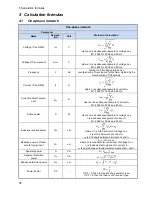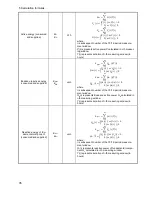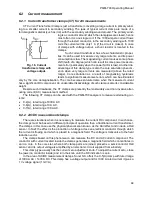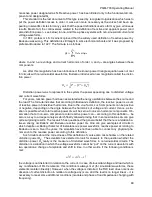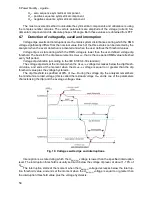
6 Power Quality - a guide
45
6.2.3 Flexible current probes
Flexible Current Probes are based on a totally differ-
ent physical principle than the current transformer. Their
principal part is a so-called Rogowski coil, named after
German physicist Walter Rogowski. It is an air-core coil
wound around a conductor with current. Special design
of the coil allows leading out its both ends on the same
side, thus facilitating clamp placement around the con-
ductor (the return end is placed inside the coil at its entire
length). The current flowing through the measured con-
ductor causes centric magnetic field lines which due to
the self-induction phenomenon induce the electromotive
force at the end of the coil. This voltage, however, is pro-
portional to the rate of current change in the conductor,
and not to the current itself.
In comparison with current transformers, the
Rogowski coil has a few indisputable advantages. As it
does not have a core, the core saturation effect is elimi-
nated; thus being a perfect instrument to measure large
currents. Such coil has also an excellent linearity and a
wide pass band, much wider than a current transformer,
and its weight is much smaller.
However, until recently the wider expansion of flex-
ible clamps in the current measurement area was diffi-
cult. There are some factors which hinder practical implementation of a measurement system with
a Rogowski coil. One of them is a very low voltage level which is induced on the clamps (it depends
on geometrical dimensions of the coil). For example, the output voltage for the 50 Hz frequency of
the F-series flexible probes (to be used with PQM-700) is about 45
µV/A. Such low voltages require
the use of precise and low-noise amplifiers which of course increase the costs.
Because the output voltage is proportional to the current derivative, it is necessary to use an
integrating circuit; generally, the flexible probes comprise a Rogowski coil and an analog integrator
circuit (characteristic battery-powered module). On the integrator output available is the voltage
signal proportional to measured current and suitably scaled (for example 1 mV/A).
Another problem connected with the Rogowski coil is its sensitivity to external magnetic fields.
A perfect coil should be sensitive only to the fields closed within its area and should totally suppress
external magnetic fields. But this is a very difficult task. The only way to obtain such properties is
very precise manufacture of the coil, with perfectly homogenous windings and impedance as low
as possible. It is the high precision which causes a relatively high price of such probe.
The PQM-700 analyzer can be used with the following flexible probes from Sonel S.A.:
F-1(A), with coil circumference 120 cm,
F-2(A), with coil circumference 80 cm,
F-3(A), with coil circumference 45 cm.
All these probes have identical electrical parameters. The peak current which can be measured
after connecting to PQM-700 is about 10 kA (the limitation is due to the properties of the input
channels, and not the probe itself).
6.3
Flicker
In terms of power quality, flicker means a periodical changes of the luminous intensity as a
result of fluctuations of voltage supplied to light bulbs.
The flicker measurement function appeared in the power quality analyzers when it turned out
that this phenomenon causes a deteriorated well-being, annoyance, sometimes headache, etc. The
luminous intensity fluctuations must have a specified frequency, they may not be to slow as then
human iris can adapt to changed lighting, and they may not be too fast because the filament inertia
Fig. 17. Rogowski coil.
Summary of Contents for PQM-700
Page 85: ...85 Notes...



